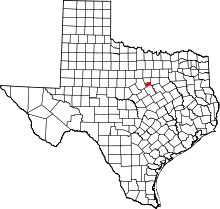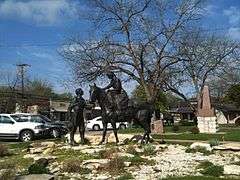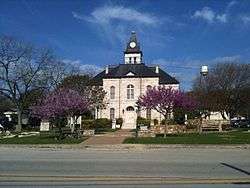Somervell County, Texas
| Somervell County, Texas | |
|---|---|
|
The Somervell County Courthouse in Glen Rose | |
 Location in the U.S. state of Texas | |
 Texas's location in the U.S. | |
| Founded | 1875 |
| Seat | Glen Rose |
| Largest city | Glen Rose |
| Area | |
| • Total | 192 sq mi (497 km2) |
| • Land | 186 sq mi (482 km2) |
| • Water | 5.5 sq mi (14 km2), 2.9% |
| Population | |
| • (2010) | 8,490 |
| • Density | 46/sq mi (18/km²) |
| Congressional district | 25th |
| Time zone | Central: UTC-6/-5 |
| Website |
co |
Somervell County (/ˈsʌmərvɛl/ SUM-er-vell) is a county located on the Edwards Plateau in the U.S. state of Texas. As of the 2010 census, its population was 8,490.[1] Its county seat is Glen Rose.[2] The county is named for Alexander Somervell, Secretary of War for the Republic of Texas.
Somervell County is included in the Dallas-Fort Worth-Arlington, TX Metropolitan Statistical Area and the Granbury Micropolitan Area.
The county contains the Comanche Peak Nuclear Generating Station, one of two nuclear power plants in Texas.
History


Native Americans
Caddo tribe Anadarko villages were scattered along Trinity and Brazos Rivers.[3] The Caddo tribe of Wichita also inhabited the area. The Anadarko became entangled with the French battles with the Spanish and later the Anglos and suffered the consequences, including diseases for which they had no immunity. By 1860, these tribes moved to Oklahoma.
The Tonkawa[4] were hunter-gatherers of the area, and often traded with their allies the Caddo and Karankawa. Like the Wichita, Karankawa and Jumano, the Tonkawa tattooed their bodies and faces. Friendly with the white settlers, Tonkawa were employed as scouts for the Texas Rangers and United States Army.[5] As they were pushed out by the Comanche, they moved to the Brazos Indian Reservation,[6] and later to Oklahoma
Comanche bands continued depredations on settlers until their removal to Oklahoma after 1875.[7]
County established
The county was formed and organized in 1875 from Hood County. The town of Glen Rose became the county seat.
Torrey Trading Houses opened as a part of the Sam Houston peace policy to develop friendly relationships with native tribes.[8] They bought from, and sold to, the Indians on a banking and credit system, enabling them to also recover stolen horses and human captives. The Torreys sold their business to George Barnard in 1848,[9] who with his brother Charles [10] moved the Tehuacana store in Limestone County to near Comanche Peak.[11] Juana Josefina Cavazos[12] had been captured by Comanches as a teenager. She was daughter of Maria Josefa Cavazos,[13] and granddaughter of Don José Narciso Cavazos Gonzalez-Hildago who in 1792 received the largest land grant in Texas.[14] George ransomed Juana from the tribe, but it was brother Charles who married her in 1848.[15]
Somervell County got its first courthouse in Glen Rose in 1882, but the courthouse and all county records burned in 1893.[16] The second and current courthouse was built in 1894 by architect John McCormick.[17] The roof and clock tower were damaged in the 1902 Glen Rose tornado. County funds at the time limited the repair, which eliminated the clock tower. In 1986, work was done to restore the structure to its original design.
Glen Rose Collegiate Institute, AKA Glen Rose College, operated as a private faith-based educational facility from 1889 to 1910. Educational competition from the public school system caused enrollment to taper off until the institution was shut down.[18]
Under the New Deal Works Progress Administration, Glen Rose built a new water and sewage system in the 1930s, as well as school buildings, a canning plant, and low-water dams.[19]
The Comanche Peak Nuclear Power Plant went online in the mid 1970s and employs over 1,000 people.[20] Squaw Creek Reservoir, which provides cooling water for the power plant, also has become a popular recreation site.[21]
Dinosaurs
The tragic Paluxy River flood in 1908 uncovered 3-toed prints from the Cretaceous period, possibly Acrocanthosaurus, and were discovered by high school student George Adams in the limestone river bed. The teenager related the discovery to his principal, Robert McDonald.[22] Adams later ended up selling self-manufactured fake "giant man tracks"[23] to tourists sometime during the 1930s, sparking a debate about whether or not humans existed alongside dinosaurs.[24] In 1934, resident Charlie Moss discovered footprints of 4-toed sauropods. Resident Jim Ryals dug out the actual dinosaur prints and sold them to tourists. Paleontologist Roland T. Bird of the American Museum of Natural History in New York spotted the Adams "giant man tracks" in a tourist shop in Gallup, New Mexico, and, while recognizing them as fakes, was still intrigued enough to travel to Somervell County to see the Glen Rose area for himself. Bird's visit resulted in a 2-year WPA project to uncover the dinosaur prints. The American Museum of Natural History, the University of Texas at Austin, the Smithsonian Institution, and several local museums retain samples of what are said to be the best-preserved tracks in the United States.[25]
The land along the Paluxy River for Dinosaur Valley State Park was purchased by the State of Texas in 1968, and the park opened to the public in 1972.[26]
Geography
According to the U.S. Census Bureau, the county has a total area of 192 square miles (500 km2), of which 186 square miles (480 km2) is land and 5.5 square miles (14 km2) (2.9%) is water.[27] It is the second-smallest county by area in Texas, larger than only Rockwall County, and slightly smaller than Camp County.
Major highways
Adjacent counties
- Hood County (north)
- Johnson County (east)
- Bosque County (south)
- Erath County (west)
Demographics
| Historical population | |||
|---|---|---|---|
| Census | Pop. | %± | |
| 1880 | 2,649 | — | |
| 1890 | 3,419 | 29.1% | |
| 1900 | 3,498 | 2.3% | |
| 1910 | 3,931 | 12.4% | |
| 1920 | 3,563 | −9.4% | |
| 1930 | 3,016 | −15.4% | |
| 1940 | 3,071 | 1.8% | |
| 1950 | 2,542 | −17.2% | |
| 1960 | 2,577 | 1.4% | |
| 1970 | 2,793 | 8.4% | |
| 1980 | 4,154 | 48.7% | |
| 1990 | 5,360 | 29.0% | |
| 2000 | 6,809 | 27.0% | |
| 2010 | 8,490 | 24.7% | |
| Est. 2015 | 8,739 | [28] | 2.9% |
| U.S. Decennial Census[29] 1850–2010[30] 2010–2014[1] | |||
As of the census[31] of 2000, there were 6,809 people, 2,438 households, and 1,840 families residing in the county. The population density was 36 people per square mile (14/km²). There were 2,750 housing units at an average density of 15 per square mile (6/km²). The racial makeup of the county was 92.19% White, 0.28% Black or African American, 0.69% Native American, 0.26% Asian, 0.01% Pacific Islander, 5.11% from other races, and 1.45% from two or more races. 13.44% of the population were Hispanic or Latino of any race.
There were 2,438 households, of which 37.40% had children under the age of 18 living with them, 61.70% were married couples living together, 9.60% had a female householder with no husband present, and 24.50% were non-families. 21.30% of all households were made up of individuals and 9.20% had someone living alone who was 65 years of age or older. The average household size was 2.73 and the average family size was 3.17. As of the 2010 census, there were about 1.3 same-sex couples per 1,000 households in the county.[32]
In the county, the population was spread out with 28.40% under the age of 18, 7.70% from 18 to 24, 26.80% from 25 to 44, 23.70% from 45 to 64, and 13.30% who were 65 years of age or older. The median age was 37 years. For every 100 females there were 99.60 males. For every 100 females age 18 and over, there were 95.90 males.
The median income for a household in the county was $39,404, and the median income for a family was $46,458. Males had a median income of $32,463 versus $23,381 for females. The per capita income for the county was $18,367. About 6.10% of families and 8.60% of the population were below the poverty line, including 10.30% of those under age 18 and 9.10% of those age 65 or over.
Media
Two newspapers have offices located in Somervell County the Glen Rose Reporter and the Glen Rose Newspaper. The Somervell County Salon is a local blog that has video and audio of local meetings. Local Television stations that provide coverage for the area broadcast from the Dallas-Fort Worth and the Waco/Temple/Killeen (Central Texas) Metropolitan areas.
Communities
See also
References
- 1 2 "State & County QuickFacts". United States Census Bureau. Retrieved December 24, 2013.
- ↑ "Find a County". National Association of Counties. Retrieved 2011-06-07.
- ↑ "Andarko Indian History". Access Genealogy. Retrieved 28 April 2010. Access Genealogy
- ↑ "Indian Intruders From The North". Texas Beyond History. Retrieved 28 April 2010. Texas Beyond History
- ↑ "Texas Indians, The Tonkawa". R. Edward Moore and Texarch Associates. Retrieved 28 April 2010. R. Edward Moore and Texarch Associates
- ↑ Crouch, Carrie J: Brazos Indian Reservation from the Handbook of Texas Online. Retrieved 28 April 2010. Texas State Historical Association.
- ↑ "Texas Indians Map". R E. Moore and Texarch Associates. Retrieved 28 April 2010. R E. Moore and Texarch Associates
- ↑ Armbruster, Henry C.: Torrey Trading Houses from the Handbook of Texas Online. Retrieved 28 April 2010. Texas State Historical Association.
- ↑ Willingham, John: George Barnard from the Handbook of Texas Online. Retrieved 28 April 2010. Texas State Historical Association.
- ↑ Andrus, Pearl: Charles E. Bernard from the Handbook of Texas Online. Retrieved 28 April 2010. Texas State Historical Association.
- ↑ Comanche Peak from the Handbook of Texas Online. Retrieved 28 April 2010. Texas State Historical Association.
- ↑ Orozco, Cynthia E.: Juana Josefina Cavasos Barnard from the Handbook of Texas Online. Retrieved 28 April 2010. Texas State Historical Association.
- ↑ "Descendants of Don José Narciso Cavazos Gonzalez-Hildago" (PDF). Villa de San Agustin-Laredo Genealogy Society. Retrieved 28 April 2010.
- ↑ "San Juan de Carrictios Land Grant". Texas Historical Markers. Retrieved 28 April 2010.
- ↑ "Juana Cavasos Barnard". Hood County Genealogical Society. Retrieved 28 April 2010.
- ↑ "First Somerville County Courthouse". Texas Historical Markers. Retrieved 28 April 2010.
- ↑ "Second Somerville County Courthouse". Texas Escapes. Retrieved 28 April 2010.
- ↑ Hart, Brian: Glen Rose Collegiate Institute from the Handbook of Texas Online. Retrieved 28 April 2010. Texas State Historical Association.
- ↑ Elam, Richard: Somervell County from the Handbook of Texas Online. Retrieved 28 April 2010. Texas State Historical Association.
- ↑ "Comanche Peak Steam Electric Station". Glenrosearea.com. Retrieved 28 April 2010.
- ↑ "Squaw Creek Reservoir". Going Outside.com. Retrieved 28 April 2010.
- ↑ Jasinski, Laurie E. "Speaking of Texas, Glen Rose's Dinosaur Highway". Texas Highways. Retrieved 15 January 2015.Texas Highways
- ↑ Michon Scott. "Strange Science, Forgeries and Frauds". Michon Scott. Retrieved 28 April 2010.
- ↑ "Human and Dinosaur Footprints". Creation vs. Evolution Resources. Retrieved 28 April 2010. Visual Evolution. Keep it real
- ↑ Glen J. Kuban. "A Brief History of Dinosaur Tracks in Glen Rose, Texas". Kuban, Glen J. Retrieved 28 April 2010.
- ↑ "Dinosaur Valley State Park". Texas Parks and Wildlife Department. Retrieved 28 April 2010. TPWD
- ↑ "2010 Census Gazetteer Files". United States Census Bureau. August 22, 2012. Retrieved May 10, 2015.
- ↑ "County Totals Dataset: Population, Population Change and Estimated Components of Population Change: April 1, 2010 to July 1, 2015". Retrieved July 2, 2016.
- ↑ "U.S. Decennial Census". United States Census Bureau. Retrieved May 10, 2015.
- ↑ "Texas Almanac: Population History of Counties from 1850–2010" (PDF). Texas Almanac. Retrieved May 10, 2015.
- ↑ "American FactFinder". United States Census Bureau. Retrieved 2011-05-14.
- ↑ Where Same-Sex Couples Live, June 26, 2015, retrieved July 6, 2015
External links
- Somervell County
- Somervell County from the Handbook of Texas Online
- Glen Rose Information
 |
Hood County |  | ||
| Erath County | |
Johnson County | ||
| ||||
| | ||||
| Bosque County |
Coordinates: 32°13′N 97°46′W / 32.22°N 97.77°W

